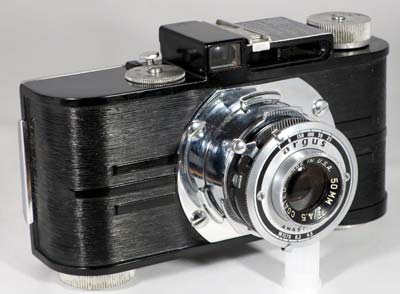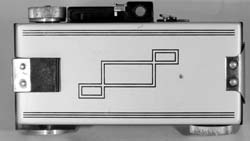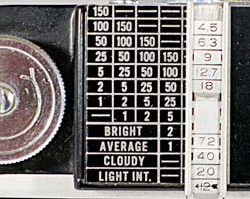Argus A2B Post-War
Specification

| Manufacturer | : | Argus |
|---|---|---|
| Produced | : | 1945 - 1950 |
| Classification | : | Miniature |
| Body Type | : | Extending Solid Body |
| Construction | : | Bakelite/Metal |
| Film Type | : | 135 |
| Film Width | : | 35mm |
| Image Size | : | 36mm x 24mm |
| No. of Images | : | 36 |
| Lens Type | : | Anastigmat - coated |
| Focal Length | : | 50mm |
| Focus Type | : | 2 Position |
| Focal Range | : | 6ft - 18ft and 18ft - Inf. |
| Aperture Type | : | 9 leaf Iris |
| Apertures | : | f/4.5 - f/18 |
| Shutter Type | : | Ilex Post War |
| Shutter Speeds | : | T, B, I(1/25s, 1/50s, 1/100s, 1/150s) |
| Size Open (w x h x d) | : | 130 x 75 x 66 mm |
| Size Closed (w x h x d) | : | 120 x 68 x 54 mm |
| Weight | : | 430g |
Art Deco Credentials
![]()
![]()
![]()
Noteworthy: Worth giving special attention
- Produced after the main Art Deco period.
- Bakelite body with triple bar design.
- Streamline Moderne curvilinear body design with horizontal stripes
- Symmetrical Art Deco geometric design on film door.
- Chrome lens pop-out and door latches
- Aluminium winder, rewind knob, frame counter and tripod connection.
- Circular design on face plate.
Description

The Argus A2B is one of a family of eight Argus A cameras built over fifteen years. It was based on the first Model A which established the use of the 35mm camera in the USA. It's curvilinear design, horizontal stripes and restrained decoration give it an Art Deco Streamline Moderne character. It differs from the pre-war model in that the lens is coated and the knobs and film frame indicator are now aluminium instead of chrome.
The coated lens sits on a spring loaded chrome cylinder which can be released from the body. It springs out to the 18ft - infinity focus position. By turning it back a little is springs out further to the 6-18ft position. Like the Argus A, it's a nice small package, especially with the lens collapsed.

As the film is wound on, a dial indicates which frame you are exposing. The film can be wound to the next frame by releasing the film using a small hexagonal plunger.
The Argus A2B version introduced an Extinction Meter. The Extinction Meter has a series of small windows with small pieces of celluloid with varying opacities. You look through these windows towards the scene and shift the bridge to the one where light is just visible. Then, by a somewhat complicated procedure, the Extinction Meter is able to automatically indicate lens aperture and shutter speeds.
How to Use
The exposure calculator isn't much use because the celluloid indicators are often faded or black and the calculator relates to old slow film.
Shutter speeds vary from 1/150s down to 1/25s. Aperture selection points are f/18, f/12.7, f/9, f/6.3, f/4.5
If you don't want to bother with an exposure meter, follow the guide shown. It is based on the 'Sunny 16' rule. Film is so forgiving and will produce acceptable results even when overexposed by 2 or 3 stops or underexposed by 1 stop. The table gives a modicum of overexposure.
Remember that the exposure guide in the camera user manual may not be helpful as it is based on the use of old film with a low ISO value.
The tables assume that the sun is at least 30 degrees above the horizon - that's 10am - 5pm on a summer's day in the UK.
If you are not sure about the light level, err on the side of overexposure - i.e. assume the smaller f number.
Where there is a choice, a larger f number will give a larger depth of field.
For the slower speeds, you may need a tripod to stop blur through shake.
Using ISO 100/125 film
| Weather Conditions | Shadow Detail | Shutter Speed (s) | |||
|---|---|---|---|---|---|
| 1/25 | 1/50 | 1/100 | 1/150 | ||
 Sunny SunnySnow/Sand | Dark with sharp edges | - | - | f/18 | f/12.7 |
 Sunny Sunny | Distinct | - | f/18 | f/12.7 | f/9 |
 Slight Overcast Slight Overcast | Soft around edges | f/18 | f/12.7 | f/9 | f/6.3 |
 Overcast Overcast | Barely visible | f/12.7 | f/9 | f/6.3 | f/4.5 |
 Heavy Overcast Heavy Overcast | None | f/9 | f/6.3 | f/4.5 | - |
 Open Shade Open Shade/Sunset | None | f/6.3 | f/4.5 | - | - |